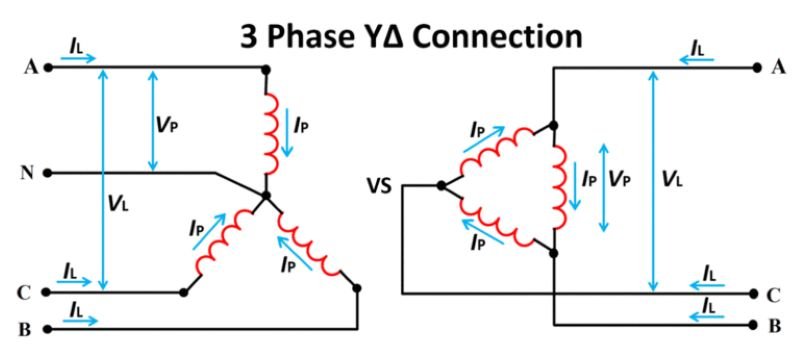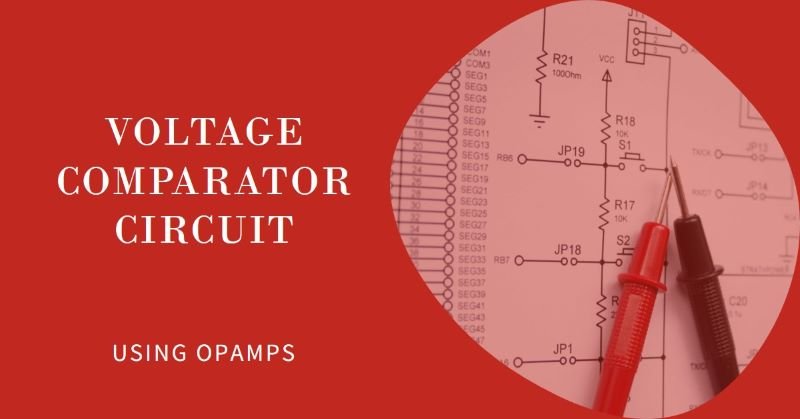Star Delta Connection in Three Phase Power System
The star-delta connection in three-phase AC systems is a foundational concept in industrial and commercial power systems. This system involves two main configurations: star (Y) and delta (Δ), each influencing voltage, current, power distribution, and overall efficiency differently. Understanding how the star-delta system operates is crucial for designing and maintaining efficient electrical networks.
Three Phase Power Systems
A three-phase power system consists of three alternating currents (AC) with the same frequency and amplitude but a 120-degree phase difference. This setup provides a more balanced and efficient power supply compared to single-phase systems. Three-phase power is widely used in various applications, from industrial machinery to electric power transmission. Star-delta connections are the two primary methods of transferring three-phase power, and we will explore each in detail.
Star (Y) Configuration
In a star configuration, each phase is connected to a common neutral point, forming a Y-shaped circuit. This setup has several advantages:
- Voltage Levels: The phase voltage (voltage between a phase and the neutral point) is lower than the line voltage (voltage between two phases). The relationship is given by Vline=3×VphaseV_{\text{line}} = \sqrt{3} \times V_{\text{phase}}. This allows for safer and more manageable voltage levels in certain applications.
- Neutral Point: The neutral point provides a return path for unbalanced currents, enhancing system stability and safety.
- Applications: Star configuration is commonly used in power distribution systems where different voltage levels are needed, such as in residential and commercial buildings.
Delta (Δ) Configuration
In a delta configuration, the ends of each phase winding connect to form a closed loop, resembling a triangle (Δ). This setup has unique advantages:
- High Power Applications: Delta configuration can handle higher power loads because the line current equals the phase current, while the line voltage is the same as the phase voltage.
- No Neutral Point: The absence of a neutral point simplifies the wiring and reduces the number of conductors needed.
- Applications: Delta configuration is often used in industrial settings for driving heavy machinery, motors, and other high-power equipment.
Star-Delta Conversion
Star-delta conversion is a method used to start large motors to reduce the initial inrush current and mechanical stress. The motor starts in a star configuration, which lowers the starting voltage and current. After the motor reaches a certain speed, it switches to a delta configuration for normal operation. This process is crucial for extending motor lifespan and reducing the impact on the electrical network.
Three Phase Power Formulas
Understanding the key formulas is essential for analyzing and designing three-phase systems:

| Parameter | Star (Y) Connection | Delta (Δ) Connection |
|---|---|---|
| Line Voltage (VL) | VL = √3×Vph | VL = Vph |
| Phase Voltage (VPh) | Vph = VL/√3 | Vph = VL |
| Line Current (IL) | IL = Iph | IL = √3×Iph |
| Phase Current (IPh) | Iph = IL | Iph = IL/√3 |
| Apparent Power (S) | S = √3×VL×IL | S = √3×VL×IL |
| Active Power (P) | P = √3×VL×ILxcos(ϕ) | P = √3×VL×IL×cos(ϕ) |
| Reactive Power (Q) | Q = 3×VL×ILx | Q = √3×VL×IL×sin(ϕ) |
| Impedance (Z) | Zph = ZL/√3 | Zph = ZL/√3 |
| Power Factor (PF) | PF = cos(ϕ) | PF = cos(ϕ) |
Advantages of Star-Delta Systems
- Reduced Starting Current: The star-delta starting method significantly reduces the inrush current, minimizing the risk of damage to the motor and electrical components.
- Cost-Effective: Star-delta starters offer a relatively inexpensive and cost-effective solution for starting large motors in industrial applications.
- Ease of Implementation: Star-delta systems are straightforward to design and implement, easily integrating into existing electrical systems without requiring significant modifications.
- Improved Motor Lifespan: Reducing the starting current minimizes the mechanical stress on the motor, extending its operational life and reducing maintenance costs.
- Energy Efficiency: Star-delta starting reduces energy consumption during the motor startup phase, leading to lower operational costs and improved energy efficiency.
- Flexibility: The ability to switch between star and delta configurations allows for greater control over the motor’s operating conditions, beneficial for handling varying load requirements in industrial applications.
Disadvantages of Star-Delta Systems
- Transition Time: The transition from star to delta configuration can cause a brief interruption in the power supply, potentially leading to a momentary dip in motor performance or instability.
- Complex Control Circuit: The control circuitry for star-delta starters can be complex, increasing the likelihood of faults and requiring more sophisticated maintenance.
- Limited Starting Torque: The initial starting torque in the star configuration is reduced, which can be a limitation for applications requiring high starting torque.
- Size and Space: Star-delta starters can be physically larger than other starting methods, requiring more space within electrical panels or enclosures.
- Not Suitable for Frequent Starts and Stops: Star-delta starters are not ideal for applications that require frequent starts and stops, as constant switching between configurations can lead to wear and tear on the starter components.
- Potential for Voltage Imbalance: During the transition phase, there can be a potential for voltage imbalance, affecting the stability and performance of the motor.
Applications of Star-Delta Systems
- Industrial Machinery: Used in industries to start and run large motors for conveyor belts, pumps, and compressors.
- HVAC Systems: Employed in heating, ventilation, and air conditioning systems for efficient operation of chillers and air handlers.
- Power Distribution: Utilized in electrical power distribution networks to ensure stable and efficient power delivery.
- Water Treatment Plants: Used to manage large motors driving pumps, mixers, and other equipment.
- Mining Industry: Starts and runs large motors for crushers and hoists.
- Cement Industry: Operates large motors for kilns and mills.
- Textile Industry: Manages large motors driving looms and spinning machines.
- Agriculture: Starts and runs motors for irrigation pumps and other equipment.
Difference Between Star and Delta Connection

| Feature | Star Configuration | Delta Configuration |
|---|---|---|
| Connection | Each phase connected to a common neutral point, forming a ‘Y’ shape. | Ends of each phase winding connected to form a closed loop, forming a triangle. |
| Voltage Relationship | Line Voltage VL = √3×Vphase | Line Voltage VL = Vphase |
| Current Relationship | Line Current IL=Iphase | Line Current IL = √3×Iphase |
| Neutral Point | Yes, provides a return path for unbalanced currents. | No neutral point, simplifying wiring. |
| Voltage Levels | Lower phase voltage compared to line voltage, suitable for safer and more manageable voltages. | Phase and line voltages are equal, allowing for higher power applications. |
| Starting Method | Commonly used for starting large motors to reduce inrush current. | Not typically used for starting, but provides high power during operation. |
| Power Handling | Suitable for systems requiring different voltage levels, such as residential and commercial buildings. | Suitable for high power applications like industrial machinery. |
| Efficiency | High efficiency due to the lower phase voltage reducing losses. | High efficiency in power transmission and heavy load applications. |
| Complexity | Slightly more complex due to the need for a neutral wire. | Simpler wiring with fewer conductors needed. |
| Applications | Power distribution systems, residential and commercial buildings, and starting large motors. | Industrial settings, driving heavy machinery, motors, and high-power equipment. |
| Protection | Easier to protect against phase loss with the presence of a neutral point. | More difficult to detect and protect against phase loss without a neutral point. |
| Fault Tolerance | Better fault tolerance due to the neutral point, which can handle unbalanced loads. | Less fault tolerant; unbalanced loads can cause significant issues. |
| Current Distribution | Equal current distribution among phases with the neutral providing a return path. | Currents circulate within the loop, making it efficient for balanced loads but problematic for unbalanced ones. |
Conclusion
In conclusion, The three-phase star-delta system is vital in electrical engineering, offering numerous benefits in terms of efficiency, safety, and flexibility. By understanding the principles and applications of star and delta configurations, engineers can design and maintain robust electrical systems that meet the diverse demands of industrial, commercial, and residential settings.








